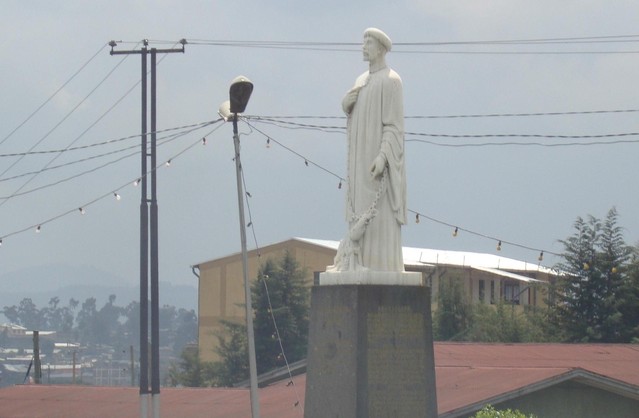 In the following article for Global Voices, a lecturer at Arba Minch University, writes about the online Ethiopian community reaction to the recent unconfirmed reports circulating on the web that iconic statues of Abune Petros, shown above, and Emperor Menelik II might be destroyed because of the construction of an Addis Ababa rail tunnel. (Photo: Abune Petros Square in Addis Ababa. The imposing monument is dedicated to the Ethiopian Orthodox Bishop who was executed by the Italian occupation forces on July 29th, 1936 in front of a large crowd at the edge of this very square/Creative Commons)
In the following article for Global Voices, a lecturer at Arba Minch University, writes about the online Ethiopian community reaction to the recent unconfirmed reports circulating on the web that iconic statues of Abune Petros, shown above, and Emperor Menelik II might be destroyed because of the construction of an Addis Ababa rail tunnel. (Photo: Abune Petros Square in Addis Ababa. The imposing monument is dedicated to the Ethiopian Orthodox Bishop who was executed by the Italian occupation forces on July 29th, 1936 in front of a large crowd at the edge of this very square/Creative Commons)
It was in 1896 that Ethiopian forces led by Emperor Menelik II had defeated an Italian army with better contemporary military technology at the Battle of Adwa. Subsequently, the victorious Emperor had brought in a range of technologies including railway to transform his country. For his triumph at Adwa and for his endeavor to change Ethiopia in his own ways, a statue in his honor was erected at the center of Addis Ababa called Arada.
Almost forty years later, in 1935, the Italians launched a new but a prearranged military campaign endorsed by their then belligerent leaders. The Italians managed to have a brief military occupation of Ethiopia but faced a staunch resistance from Ethiopians.
Pope Abune Petros, who was among the first Popes of Ethiopian Orthodox Church, was the leading figure of the resistance in Ethiopia. The Italians never liked what he was doing as a patriot and tried to stop him. He was forced to appear before General Rodolfo Graziani to submit and declare the Ethiopian patriots as bandits. He refused to comply with their demand and condemned the aggressors instead. He asked Ethiopians to struggle for their freedom. Finally, the Italians executed him in public. As it was done with Emperor Menelik II, a statue of Abune Petros was built at the center of Addis Ababa as reminiscent of his unwavering stand for his country.
However, unconfirmed reports are circulating online that the two iconic statues found on an historical thoroughfare might get wrecked due to an Addid Ababa rail tunnel construction project. The reports have not been received well by some netizens.
Read more at Global Voices Online.

























